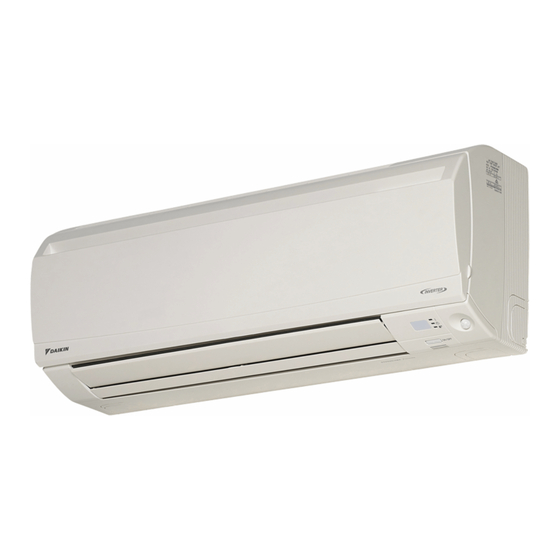
Summarization of Contents
Feature Overview
Intelligent Eye Operation
Detects human movement to automatically switch to energy saving mode.
Weekly Timer Operation
Allows up to 4 timer settings per day according to family lifestyle.
Comfort Airflow Control
Adjusts airflow direction for comfortable air distribution in COOL/HEAT modes.
Outdoor Unit Quiet Operation
Lowers outdoor unit noise for neighbourhood consideration.
Safety Precautions
Warning Precautions
Instructions to prevent personal injury or loss of life.
Caution Precautions
Instructions to prevent property damage or serious personal injury.
Name of Parts
Indoor Unit Components
Identifies key parts of the indoor air conditioning unit.
Outdoor Unit Components
Identifies key parts of the outdoor air conditioning unit.
Remote Controller Overview
Details the components and display of the remote control unit.
Preparation and Setup
Setting the Remote Control Batteries
Instructions for installing batteries in the remote controller.
Installing the Remote Controller Holder
Guidance on mounting the remote control holder on a wall.
Setting the Clock
Procedure to set the internal clock for accurate timer functions.
Operation Modes
AUTO, DRY, COOL, HEAT, FAN Operation
Explains how to select and use different air conditioner operating modes.
Airflow Direction Control
Auto Swing and Airflow Direction
Instructions for setting automatic airflow swing and direction.
3-D Airflow Direction
Enables simultaneous control of horizontal and vertical airflow for room-wide comfort.
Setting Flaps/Louvers Position
How to manually set the desired flap or louver position.
Comfort and Energy Saving Features
Comfort Airflow Operation
Directs airflow upwards in COOL and downwards in HEAT for comfort.
Intelligent Eye Energy Saving
Automatically adjusts operation for energy saving when no one is detected.
Combined Comfort and Intelligent Eye
Utilizing both comfort airflow and intelligent eye functions simultaneously.
Powerful Operation
Starting Powerful Operation
Maximizes cooling/heating effect quickly for a set duration.
Outdoor Unit Quiet Operation
Activating Outdoor Unit Quiet Mode
Reduces noise from the outdoor unit for quiet operation, especially at night.
ECONO Operation
Activating ECONO Operation
Limits maximum power consumption for energy efficiency and circuit protection.
Timer Operations
Setting the OFF Timer
Automatically switches the air conditioner off at a preset time.
Setting the ON Timer
Automatically switches the air conditioner on at a preset time.
Combining ON and OFF Timers
How to set both ON and OFF timers for sequential operation.
Weekly Timer Operation
Using the Weekly Timer
Schedule daily operations with up to 4 settings per day for a week.
Setting Up Weekly Timer Programs
Step-by-step guide to configure daily on/off times and temperatures.
Copying Weekly Timer Settings
Efficiently copy settings from one day to multiple other days.
Confirming Weekly Timer Reservations
Reviewing programmed settings for the weekly timer.
Deactivating Weekly Timer
Temporarily disabling the weekly timer function.
Deleting Weekly Timer Reservations
Removing individual or all programmed timer settings.
Multi System Operation Notes
Selecting Operation Mode in Multi System
Guidelines for choosing modes when multiple indoor units are connected.
Night Quiet Operation for Multi Systems
Specifics on reducing outdoor unit noise for multi-unit installations.
Outdoor Unit Quiet for Multi Systems
How quiet operation applies when multiple indoor units are linked.
Cool/Heat Mode Lock
Forcing specific cooling or heating operation across all units.
Priority Room Setting
Designating a priority room to influence operation modes of other units.
Care and Cleaning
Opening and Closing the Front Panel
Instructions for safely accessing the unit's interior for cleaning.
Cleaning the Front Panel
Detailed steps for cleaning the removable front panel.
Cleaning the Air Filters
Procedure for vacuuming or washing the air filters for optimal performance.
Cleaning the Titanium Apatite Filter
Maintenance for the deodorizing filter, including cleaning and replacement.
Maintenance and Storage
Unit Checks and Preparation for Idle Period
Steps for checking unit condition and preparing for long-term non-use.
Periodic Maintenance Recommendations
Advice on professional servicing for long-term performance.
Troubleshooting Common Issues
Indoor Unit Operational Checks
Addresses common non-trouble situations like flap movement and operation delays.
Sound-Related Issues
Explains normal operational sounds like water flow or blowing sounds.
General Troubleshooting Guide
Covers issues like no operation, poor heating, and sudden stops.
Mist Emission from Indoor Unit
Explanation for mist appearing during cooling or defrost operations.
Poor Cooling/Heating Effect
Troubleshooting steps for reduced performance.
Remote Controller Malfunctions
Diagnosing and resolving issues with the remote control.
Emergency Procedures and Service
Immediate Service Call Recommendations
Conditions requiring immediate contact with a service shop.
Advanced Troubleshooting
Remote Controller Fault Diagnosis
Using the remote controller to diagnose system errors with codes.

















Need help?
Do you have a question about the FTXS50LVMN and is the answer not in the manual?
Questions and answers